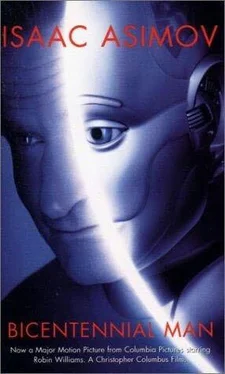Isaac Asimov - The Bicentennial Man and Other Stories
Здесь есть возможность читать онлайн «Isaac Asimov - The Bicentennial Man and Other Stories» весь текст электронной книги совершенно бесплатно (целиком полную версию без сокращений). В некоторых случаях можно слушать аудио, скачать через торрент в формате fb2 и присутствует краткое содержание. Год выпуска: 1976, ISBN: 1976, Издательство: Doubleday science fiction, Жанр: Фантастика и фэнтези, на английском языке. Описание произведения, (предисловие) а так же отзывы посетителей доступны на портале библиотеки ЛибКат.
- Название:The Bicentennial Man and Other Stories
- Автор:
- Издательство:Doubleday science fiction
- Жанр:
- Год:1976
- ISBN:ISBN: 0-385-12198-9
- Рейтинг книги:4 / 5. Голосов: 1
-
Избранное:Добавить в избранное
- Отзывы:
-
Ваша оценка:
- 80
- 1
- 2
- 3
- 4
- 5
The Bicentennial Man and Other Stories: краткое содержание, описание и аннотация
Предлагаем к чтению аннотацию, описание, краткое содержание или предисловие (зависит от того, что написал сам автор книги «The Bicentennial Man and Other Stories»). Если вы не нашли необходимую информацию о книге — напишите в комментариях, мы постараемся отыскать её.
The Bicentennial Man and Other Stories — читать онлайн бесплатно полную книгу (весь текст) целиком
Ниже представлен текст книги, разбитый по страницам. Система сохранения места последней прочитанной страницы, позволяет с удобством читать онлайн бесплатно книгу «The Bicentennial Man and Other Stories», без необходимости каждый раз заново искать на чём Вы остановились. Поставьте закладку, и сможете в любой момент перейти на страницу, на которой закончили чтение.
Интервал:
Закладка:
Usually he blanked out that image of the greatest roboticist in history because she unnerved him. (He tried thinking of the image as “it” but never quite succeeded.) This time he didn’t quite dare to and her long-dead gaze bored into the side of his face.
It was a dreadful and demeaning step he would have to take. Opposite him was George Ten, calm and unaffected either by Harriman’s patent uneasiness or by the image of the patron saint of robotics glowing in its niche above.
Harriman said, “We haven’t had a chance to talk this out, really, George. You haven’t been with us that long and I haven’t had a good chance to be alone with you. But now I would like to discuss the matter in some detail.”
“I am perfectly willing to do that,” said George. “In my stay at U. S. Robots, I have gathered the crisis has something to do with the Three Laws.”
“Yes. You know the Three Laws, of course.”
“I do.”
“Yes, I’m sure you do. But let us dig even deeper and consider the truly basic problem. In two centuries of, if I may say so, considerable success, U. S. Robots has never managed to persuade human beings to accept robots. We have placed robots only where work is required that human beings cannot do, or in environments that human beings find unacceptably dangerous. Robots have worked mainly in space and that has limited what we have been able to do.”
“Surely,” said George Ten, “that represents a broad limit, and one within which U. S. Robots can prosper.”
“No, for two reasons. In the first place, the boundaries set for us inevitably contract. As the Moon colony, for instance, grows more sophisticated, its demand for robots decreases and we expect that, within the next few years, robots will be banned on the Moon. This will be repeated on every world colonized by mankind. Secondly, true prosperity is impossible without robots on Earth. We at U. S. Robots firmly believe that human beings need robots and must learn to live with their mechanical analogues if progress is to be maintained.”
“Do they not? Mr. Harriman, you have on your desk a computer input which, I understand, is connected with the organization’s Multivac. A computer is a kind of sessile robot; a robot brain not attached to a body—”
“True, but that also is limited. The computers used by mankind have been steadily specialized in order to avoid too humanlike an intelligence. A century ago we were well on the way to artificial intelligence of the most unlimited type through the use of great computers we called Machines. Those Machines limited their action of their own accord. Once they had solved the ecological problems that had threatened human society, they phased themselves out. Their own continued existence would, they reasoned, have placed them in the role of a crutch to mankind and, since they felt this would harm human beings, they condemned themselves by the First Law.”
“And were they not correct to do so?”
“In my opinion, no. By their action, they reinforced mankind’s Frankenstein complex; its gut fears that any artificial man they created would turn upon its creator. Men fear that robots may replace human beings.”
“Do you not fear that yourself?”
“I know better. As long as the Three Laws of Robotics exist, they cannot. They can serve as partners of mankind; they can share in the great struggle to understand and wisely direct the laws of nature so that together they can do more than mankind can possibly do alone; but always in such a way that robots serve human beings.”
“But if the Three Laws have shown themselves, over the course of two centuries, to keep robots within bounds, what is the source of the distrust of human beings for robots?”
“Well”—and Harriman’s graying hair tufted as he scratched his head vigorously—“mostly superstition, of course. Unfortunately, there are also some complexities involved that anti-robot agitators seize upon.”
“Involving the Three Laws?”
“Yes. The Second Law in particular. There’s no problem in the Third Law, you see. It is universal. Robots must always sacrifice themselves for human beings, any human beings.”
“Of course,” said George Ten.
“The First Law is perhaps less satisfactory, since it is always possible to imagine a condition in which a robot must perform either Action A or Action B, the two being mutually exclusive, and where either action results in harm to human beings. The robot must therefore quickly select which action results in the least harm. To work out the positronic paths of the robot brain in such a way as to make that selection possible is not easy. If Action A results in harm to a talented young artist and B results in equivalent harm to five elderly people of no particular worth, which action should be chosen?”
“Action A,” said George Ten. “Harm to one is less than harm to five.”
“Yes, so robots have always been designed to decide. To expect robots to make judgments of fine points such as talent, intelligence, the general usefulness to society, has always seemed impractical. That would delay decision to the point where the robot is effectively immobilized. So we go by numbers. Fortunately, we might expect crises in which robots must make such decisions to be few. . . . But then that brings us to the Second Law.”
“The Law of Obedience.”
“Yes. The necessity of obedience is constant. A robot may exist for twenty years without ever having to act quickly to prevent harm to a human being, or find itself faced with the necessity of risking its own destruction. In all that time, however, it will be constantly obeying orders. . . . Whose orders?”
“Those of a human being.”
“Any human being? How do you judge a human being so as to know whether to obey or not? What is man, that thou art mindful of him, George?”
George hesitated at that.
Harriman said hurriedly, “A Biblical quotation. That doesn’t matter. I mean, must a robot follow the orders of a child; or of an idiot; or of a criminal; or of a perfectly decent intelligent man who happens to be inexpert and therefore ignorant of the undesirable consequences of his order? And if two human beings give a robot conflicting orders, which does the robot follow?”
“In two hundred years,” said George Ten, “have not these problems arisen and been solved?”
“No,” said Harriman, shaking his head violently. “We have been hampered by the very fact that our robots have been used only in specialized environments out in space, where the men who dealt with them were experts in their field. There were no children, no idiots, no criminals, no well-meaning ignoramuses present. Even so, there were occasions when damage was done by foolish or merely unthinking orders. Such damage in specialized and limited environments could be contained. On Earth, however, robots must have judgment. So those against robots maintain, and, damn it, they are right.”
“Then you must insert the capacity for judgment into the positronic brain.”
“Exactly. We have begun to reproduce JG models in which the robot can weigh every human being with regard to sex, age, social and professional position, intelligence, maturity, social responsibility and so on.”
“How would that affect the Three Laws?”
“The Third Law not at all. Even the most valuable robot must destroy himself for the sake of the most useless human being. That cannot be tampered with. The First Law is affected only where alternative actions will all do harm. The quality of the human beings involved as well as the quantity must be considered, provided there is time for such judgment and the basis for it, which will not be often. The Second Law will be most deeply modified, since every potential obedience must involve judgment. The robot will be slower to obey, except where the First Law is also involved, but it will obey more rationally.”
Читать дальшеИнтервал:
Закладка:
Похожие книги на «The Bicentennial Man and Other Stories»
Представляем Вашему вниманию похожие книги на «The Bicentennial Man and Other Stories» списком для выбора. Мы отобрали схожую по названию и смыслу литературу в надежде предоставить читателям больше вариантов отыскать новые, интересные, ещё непрочитанные произведения.
Обсуждение, отзывы о книге «The Bicentennial Man and Other Stories» и просто собственные мнения читателей. Оставьте ваши комментарии, напишите, что Вы думаете о произведении, его смысле или главных героях. Укажите что конкретно понравилось, а что нет, и почему Вы так считаете.












